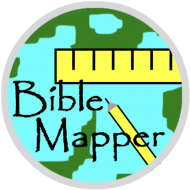Several years after Jesus ascended to heaven, a man named Paul (also called Saul) from Tarsus became a leading persecutor of Jesus’ followers (Acts 8:1-3; Philippians 3:6; 1 Timothy 1:13). He obtained permission from the high priest to arrest Jesus’ followers in Damascus and bring them back to Jerusalem. While he was traveling there, however, the risen Jesus spoke to him, and Paul himself became a believer (Acts 9:3-19). Apparently around this time he also went away into Arabia and then returned to Damascus (Galatians 1:15-18). Paul also began to preach powerfully in the synagogues of Damascus that Jesus was the Messiah (Acts 9:20-22). Later Paul went to Jerusalem and became known to the leaders of the church there. He continued to preach boldly about Jesus in Jerusalem, but fierce opposition eventually led the believers to take Paul to Caesarea and send him back to his hometown of Tarsus. Several years after this, around A.D. 45, a church leader in Antioch named Barnabas brought Paul from Tarsus to minister at the church there. Soon after this the leaders of the church at Antioch sent Paul and Barnabas to spread the gospel about Jesus the Messiah to those living on Barnabas’s home island of Cyprus and also in Galatia. Partway through the journey, Barnabas’s relative John Mark left them and returned to Jerusalem for unknown reasons (Acts 13:13). Though Paul and Barnabas suffered intense persecution in Galatia, they were successful in their ministry there and later returned to Antioch to report these things to the church leaders (Acts 13-14). As word spread that many Gentiles were becoming followers of Jesus, dissension grew regarding whether these Gentile believers were required to follow all the laws of Moses, including circumcision. Paul and Barnabas traveled to Jerusalem and participated in a church council about the matter (Acts 15). Soon after this, around A.D. 49, Paul and another leader named Silas set out on a second journey to strengthen the churches that Paul had helped to establish in Galatia, and then they carried the gospel of Jesus even further to Asia, Macedonia, and Achaia (Acts 15-18). Later, around A.D. 53, Paul set out on a third journey to strengthen the churches once again (Acts 19:1-21:17). Around A.D. 58 Paul arrived in Jerusalem and greeted the church leaders there. Several days later Paul visited the Temple, and a riot broke out by many Jews who believed that Paul was teaching people throughout the world to disregard the law of Moses. The Roman leaders transferred Paul to Caesarea to protect him as he awaited trial, and Paul’s imprisonment there lasted for two years (Acts 21-24). Paul eventually appealed his case to Caesar (Acts 26), so he was placed aboard a ship in order to make his way to Rome. Along the way, however, his ship encountered a fierce storm, and the ship was broken apart off the coast of Malta just south of Sicily and Italy. The entire crew, however, made it safely to the island, where they were treated with hospitality (Acts 27:1-28:10). Three months later, around A.D. 60, they were placed aboard another ship and made their way to Rome, where Paul lived under house arrest for two years, proclaiming the gospel without hindrance (Acts 28:11-31). Though the book of Acts ends there, comments in some of Paul’s letters, as well as church tradition, suggest that Paul was eventually released and traveled to Spain and then to Crete, Ephesus, and Nicopolis on a fourth journey (Romans 15:22-29; 2 Timothy 1:3-17; 4:10-21; Titus 1:5; 3:12). Church tradition also says that Paul was later imprisoned at Mamertine Prison in Rome and martyred during Emperor Nero’s persecutions around A.D. 67.

This map is designed to be printed at 36 in. x 24 in., but it may scale acceptably at larger or smaller sizes as well.
Order as a pre-printed, matte poster (3 ft x 2 ft). Price: $24.90, plus shipping ($9.49) and tax.




